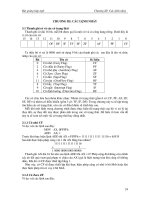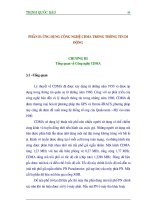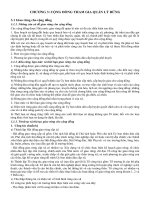slide dịch hợp đồng chương 3 negotiating inspecti class
Bạn đang xem bản rút gọn của tài liệu. Xem và tải ngay bản đầy đủ của tài liệu tại đây (530.2 KB, 35 trang )
CONTRACT
Teacher : Lê Hồng Linh ( MA)
Tel: 0903 978 552
Email :
1
1
CHAPTER: 3 NEGOTIATION INSPECTION
AND DEFECTS LIABILITY
The Problem:
When things go wrong with the exported products,
repair and replacement can be ruinously
expensive. There are some special steps that the
exporters can take to minimize the risk of the
goods being rejected or of heavy defects liability
claims.
2
2
CHAPTER: 3 NEGOTIATION INSPECTION
AND DEFECTS LIABILITY
The Principle:
+ The exporter should ensure that all exported
goods meet or exceed the quality specified, that
marking and packaging are correct and that
delivery is on time.
+ The agreement between the parties should
contain specific quality specifications.
3
3
CHAPTER: 3 NEGOTIATION INSPECTION
AND DEFECTS LIABILITY
In more depth:
The quality of the product is a key issue, and
customer satisfaction is essential to successful
business. Many companies have qualities
assurance programs to ensure that customers get
what they pay for.
4
4
CHAPTER: 3 NEGOTIATION INSPECTION
AND DEFECTS LIABILITY
In more depth:
Until things are going well in the local market, it
makes little sense to export, because quality
assurance and customer satisfaction are much
tougher when the customer is in another country,
and distance makes communication, transport,
inspection, payment and verification of claims
expensive and time-consuming.
5
5
CHAPTER: 3 NEGOTIATION INSPECTION
AND DEFECTS LIABILITY
A well-designed set of specifications offers
vital protection the both sides.
The importer is protected against inferior
products. Moreover, the seller is protected alsothrough more subtly. If the products are fully
specified and the consignment meets the
specifications, the buyer will be unable to find any
excused for rejection or for exaggerated defects
liability.
6
6
CHAPTER: 3 NEGOTIATION INSPECTION
AND DEFECTS LIABILITY
Pre-delivery Inspection
Many importers require inspection of their goods
in the manufacture’s factory before delivery. With
sophisticated items or capital equipment, the
buyer may also want to inspect the goods at preagreed times during manufacture.
7
7
CHAPTER: 3 NEGOTIATION INSPECTION
AND DEFECTS LIABILITY
Page117:
The Buyer may, at the Buyer’s option, inspect the Goods
prior to shipment. At least fourteen days before the actual
delivery date, the seller shall give notice to the Buyer, or
to any agent nominated by the Buyer, that the Goods are
available for inspection. The Seller shall permit access to
the Goods for purposes of inspection at a reasonable time
agreed by the parties
8
8
CHAPTER: 3 NEGOTIATION INSPECTION
AND DEFECTS LIABILITY
Some countries, Indonesia for example, require
that all imported goods are inspected by an
inspections service immediately before shipment.
This inspection prevents exporter and buyer
agreeing an unrealistically low invoice price in
order to avoid customs duties in the buyer’s
country. This also prevents shipments of patently
defective goods.
9
9
CHAPTER: 3 NEGOTIATION INSPECTION
AND DEFECTS LIABILITY
The next step, assuming FOB delivery, is
examination of the goods by the carrier. The
carrier does not unpack the goods or check their
quality, although leaks and obvious damage – as
well as incorrect shipping marks, defective
packaging or discrepancies in weight and size –
are noted on the shipping documents.
10
10
CHAPTER: 3 NEGOTIATION INSPECTION
AND DEFECTS LIABILITY
Inspection and Acceptance
The principle is clear- the buyer has the right to
inspect the goods when they arrive and to reject
them if they are incorrect. At this point, exact
specification is of great value to exporter if
the goods conform to specifications, the
buyer is obligated to accept them.
11
11
CHAPTER: 3 NEGOTIATION INSPECTION
AND DEFECTS LIABILITY
+ Defects Liability Period
Once the goods are accepted by the buyers as
apparently correct, they must jump to the final
hurdle – the defect liability period. The
manufacturer accepts liability for defects the come
to light after acceptance: if anything is wrong with
any item, they will repair or replace it. Such
defects are called “latent defects”.
12
12
CHAPTER: 3 NEGOTIATION INSPECTION
AND DEFECTS LIABILITY
The defects liability period is negotiable, this is
likely to be several months from the date of
delivery or the date of arrival.
Protection against dishonest claims or excessive
demands should be written into the contract.
13
13
CHAPTER: 3 NEGOTIATION INSPECTION
AND DEFECTS LIABILITY
To sum up, in negotiating the terms of the
contract, we can look at the process in steps.
Step 1. Inspection: When are the goods
inspected? And when can the buyer to reject
them?
Step 2. Terms: Warranty or guarantee?
14
14
CHAPTER: 3 NEGOTIATION INSPECTION
AND DEFECTS LIABILITY
Step 3. Definitions: What is, and what is not, a
defect?
Step 4. Timing: How long is the defects liability
period? When does it begin? What about other
timings?
Step 5. Corrective action: What must the seller do
to cure defects?
15
15
CHAPTER: 3 NEGOTIATION INSPECTION
AND DEFECTS LIABILITY
II. INSPECTION, ACCEPTANCE AND
REJECTION
The problem
When goods are delivered, the buyer inspect them. What
are the buyer’s right of rejection?
16
16
CHAPTER: 3 NEGOTIATION INSPECTION
AND DEFECTS LIABILITY
II. INSPECTION, ACCEPTANCE AND
REJECTION
The principle
The buyer can inspect goods and they can cancel the
contract if the goods do not conform the contract.
17
17
CHAPTER: 3 NEGOTIATION INSPECTION
AND DEFECTS LIABILITY
II. INSPECTION, ACCEPTANCE AND
REJECTION
In more depth
The seller promises to delivery perfect good but if they
break the promise they still have the contract because
they will fixe the problem
18
18
CHAPTER: 3 NEGOTIATION INSPECTION
AND DEFECTS LIABILITY
II. INSPECTION, ACCEPTANCE AND
REJECTION
Implied Warranties
Implied warranty of conformity with contract
Goods must conform with their description in the
contract. but what is “ conformity with contract? There
are law to deal with problem. Most laws have a way of
“grading” non-conformity.
19
19
CHAPTER: 3 NEGOTIATION INSPECTION
AND DEFECTS LIABILITY
II. INSPECTION, ACCEPTANCE AND
REJECTION
Implied Warranties
Implied warranty of merchantable quality
Goods might well conform with the contract but be
of seriously inferior quality.
20
20
CHAPTER: 3 NEGOTIATION INSPECTION
AND DEFECTS LIABILITY
II. INSPECTION, ACCEPTANCE AND
REJECTION
Implied Warranties
Implied warranty of fitness for intended purpose
Goods might conform with the contract and be
merchantable but still be useless to the buyer. If exporter
knew the buyer’s intended purpose, and if the buyer
trusted the exporter to supply correct goods, then most
laws allow the buyer to reject unusable iterms.
21
21
CHAPTER: 3 NEGOTIATION INSPECTION
AND DEFECTS LIABILITY
II. INSPECTION, ACCEPTANCE AND
REJECTION
Rejection: Total or partial
English law requires rejection of all the contract goods
unless contract expressly allows part rejection. German
law and the Vienna Sales Convention both allow rejection
of only defective or non-conforming goods.
The buyer must notify the exporter that the goods have
been rejected “within a reasonable period”.
22
22
CHAPTER: 3 NEGOTIATION INSPECTION
AND DEFECTS LIABILITY
III. WARRANTY AND GUARANTEE:
TERMINOLOGY
The problem
Are a warranty and a guarantee the same thing? Why do
some contract replace a warranty with a “defects liability
provision”?
23
23
CHAPTER: 3 NEGOTIATION INSPECTION
AND DEFECTS LIABILITY
III. WARRANTY AND GUARANTEE:
TERMINOLOGY
The principle
A guarantee is a promise about somebody else’s
performance; a warranty is a promise about your own.
24
24
CHAPTER: 3 NEGOTIATION INSPECTION
AND DEFECTS LIABILITY
III. WARRANTY AND GUARANTEE:
TERMINOLOGY
In more depth
A warranty is a promise you make about your own
performance. A product warranty is a promise by the
exporter to cure defects in his products.
25
25









